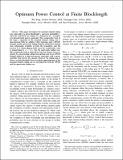Optimum Power Control at Finite Blocklength
Author(s)
Yang, Wei; Caire, Giuseppe; Durisi, Giuseppe; Polyanskiy, Yury
DownloadPolyanskiy_Optimum power.pdf (568.8Kb)
OPEN_ACCESS_POLICY
Open Access Policy
Creative Commons Attribution-Noncommercial-Share Alike
Terms of use
Metadata
Show full item recordAbstract
This paper investigates the maximal channel coding rate achievable at a given blocklength n and error probability ϵ, when the codewords are subjected to a long-term (i.e., averaged-over-all-codeword) power constraint. The second-order term in the large-n expansion of the maximal channel coding rate is characterized both for additive white Gaussian noise (AWGN) channels and for quasi-static fading channels with perfect channel state information available at both the transmitter and the receiver. It is shown that in both the cases, the second-order term is proportional to (n[superscript -1] ln n)[superscript 1/2]. For the quasi-static fading case, this second-order term is achieved by truncated channel inversion, namely, by concatenating a dispersion-optimal code for an AWGN channel subject to a short-term power constraint, with a power controller that inverts the channel whenever the fading gain is above a certain threshold. Easy-to-evaluate approximations of the maximal channel coding rate are developed for both the AWGN and the quasi-static fading case.
Date issued
2015-08Department
Massachusetts Institute of Technology. Department of Electrical Engineering and Computer ScienceJournal
IEEE Transactions on Information Theory
Publisher
Institute of Electrical and Electronics Engineers (IEEE)
Citation
Yang, Wei, Giuseppe Caire, Giuseppe Durisi, and Yury Polyanskiy. “Optimum Power Control at Finite Blocklength.” IEEE Transactions on Information Theory 61, no. 9 (September 2015): 4598–4615.
Version: Author's final manuscript
ISSN
0018-9448
1557-9654